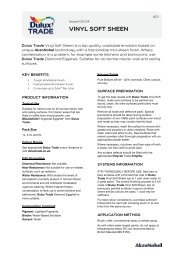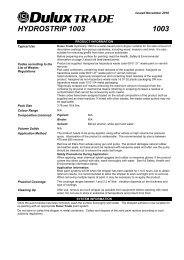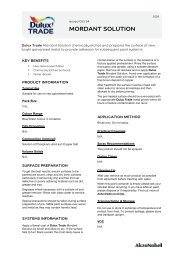Transforming the healing environment - Dulux Trade
Transforming the healing environment - Dulux Trade
Transforming the healing environment - Dulux Trade
You also want an ePaper? Increase the reach of your titles
YUMPU automatically turns print PDFs into web optimized ePapers that Google loves.
Colour in patient roomsPatient rooms should be comfortable, calm, non-intimidating, safe andpersonalised. Lighting is often subdued, so this should influence colourchoice. Excessive use of bright colours can interfere with visualdiagnosis and lead to overstimulation.NeutralsBegin by choosing a neutral. This willbe <strong>the</strong> main broad wall colour thatflows through <strong>the</strong> scheme.ColoursWard areasIt is important to keep <strong>the</strong>se areas light and fresh as colourswith too much saturation could effect visual diagnosis.To give interest, a softer palette can be used to highlightkey features such as behind <strong>the</strong> sink area, cupboard doorsor window walls. It is still important however to ensure <strong>the</strong>seareas give a modern and uplifting impression as patientsoften spend long amounts of time in <strong>the</strong>m.TimelessPaediatric UnitsOchre WhiteChildren’s wards need to be interesting and vibrant.Using a simple combination of pure accents can createan impression of fun that is appealing and reassuringto children. Using a clear and unsophisticated palettecan help to reduce patient anxiety and confusion bydistracting <strong>the</strong>ir senses.Intensive care30GY 88/014These areas need to be calming and restful. A soft neutralcolour is recommended in <strong>the</strong>se areas, however to avoida bland looking <strong>environment</strong>, muted and soothing accentscan be used in small areas.81YY 87/03122 |
















